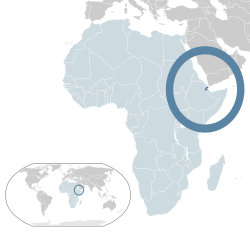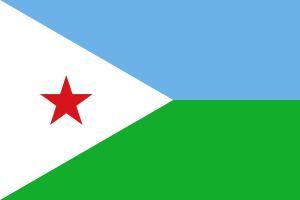Djibouti
Republic of Djibouti | |
|---|---|
| Motto: اتحاد، مساواة، سلام (Arabic) Unité, Égalité, Paix (French) Inkittiino, Qeedala, Wagari (Afar) Midnimo, Sinaan, Nabad (Somali) Unity, Equality, Peace | |
| Anthem: Djibouti | |
 Location of Djibouti (dark blue) – in Africa (light blue & dark grey) | |
 | |
| Capital and largest city | Djibouti 11°36′N 43°10′E / 11.600°N 43.167°E |
| Official languages | |
| Recognised national languages | [1] |
| Other languages | |
| Ethnic groups | |
| Religion | Sunni Islam |
| Demonym(s) | Djiboutians |
| Government | Unitary dominant-party presidential republic |
| Ismaïl Omar Guelleh | |
| Abdoulkader Kamil Mohamed | |
| Legislature | National Assembly |
| Independence | |
• from France | 27 June 1977 |
| Area | |
• Total | 23,200[1] km2 (9,000 sq mi)[1] (146th) |
• Water (%) | 0.09 (20 km² / 7.7 sq mi) |
| Population | |
• 2020 estimate | 921,804 |
• Density | 37.2/km2 (96.3/sq mi) (168th) |
| GDP (PPP) | 2018 estimate |
• Total | $3.974 billion[2] |
• Per capita | $3,788[2] |
| GDP (nominal) | 2018 estimate |
• Total | $2.187 billion[2] |
• Per capita | $2,084[2] |
| Gini (2015) | 40.0[3] medium |
| HDI (2018) | low · 171st |
| Currency | Djiboutian franc (DJF) |
| Time zone | UTC+3 (EAT) |
| Driving side | right |
| Calling code | +253 |
| ISO 3166 code | DJ |
| Internet TLD | .dj |
Djibouti (officially called the Republic of Djibouti) is a country on the eastern coast of Africa. The capital city is also called Djibouti.
Djibouti gained its independence from France on June 27, 1977. The country was created out of the French Somaliland (later called the French Territory of the Afars and Issas), which was created in the 1800s as a result of French colonialism in Africa.
In 2020, about 920,000 people lived there. It is one of the least populous countries in Africa.[5] Two ethnic groups, the Somali and the Afar people, account for most of the people living in the country.
Djibouti joined the United Nations on September 20, 1977.[6][7] It is also a member of the Arab League, as well as the African Union and the Intergovernmental Authority on Development (IGAD).
History[change | change source]
The history of Djibouti goes back thousands of years when it was part of the Sabean Empire (Ethiopia) to a time when Djiboutians traded hides and skins for the perfumes and spices of ancient Egypt, Pakistan, and China. Through close contacts with the Arabian peninsula for more than 1,000 years, the Somali and Afar tribes in this region became among the first on the African continent to accept Islam. Djibouti is a Muslim country which regularly takes part in Islamic as well as Arab meetings.
The country is close to a narrow part of the Red Sea so it is considered an important area from a military viewpoint.
Djiboutians[change | change source]
 | |
| Total population | |
|---|---|
| c. 921,000-935,000[a] | |
| Languages | |
| Somali, Afar, Arabic, French | |
| Religion | |
| Islam (100%; Sunni · Sufism),[8] | |
| Related ethnic groups | |
| Ethiopians, Eritreans, Djiboutians, Somalians (Somalis of Somalia), Horn Africans |
The Djiboutians (French: Djiboutiens) are the people inhabiting or originating from Djibouti (including their diaspora). The country is mainly composed of two ethnic groups, the Somali and the Afar. It has many languages - though Somali and Afar are the most widely spoken ones, Arabic and French serve as the official languages. There is a small Djiboutian diaspora in North America, Europe, and Australia.
Geography[change | change source]
Djibouti is near to the Horn of Africa. It is bordered by Eritrea in the north, Ethiopia in the west and south, and Awdal of Somalia in the southeast. The remainder of the border is formed by the Red Sea and the Gulf of Aden at the east.
In the Great Rift Valley the rift between the African Plate and the Somali Plate meet the Arabian Plate. This makes a geologic tripoint[9] that is the lowest place in Africa.
Djibouti has eight mountain ranges with peaks of over 1,000 m (3,281 ft).[10] The Mousa Ali range is the country's highest mountain range.
The Grand Bara desert covers parts of southern Djibouti.
Most species of wildlife are found in the northern part of the country, in the ecosystem of the Day Forest National Park. This forest area is the main habitat of the endangered and endemic Djibouti francolin (a bird).
Administrative divisions[change | change source]

Djibouti is divided into six administrative regions, with Djibouti city representing one of the official regions. It is further subdivided into twenty districts.
| Region | Area (km2) | Population (2010) | Capital |
|---|---|---|---|
| Ali Sabieh | 2,200 | 71,640 | Ali Sabieh |
| Arta | 1,800 | 40,163 | Arta |
| Dikhil | 7,200 | 83,409 | Dikhil |
| Djibouti | 200 | 529,900 (2015 est.) | Djibouti City |
| Obock | 4,700 | 36,083 | Obock |
| Tadjourah | 7,100 | 84,041 | Tadjoura |
Religion[change | change source]
The people of Djibouti are mostly Muslim. Islam is observed by 94% of Djibouti's population (about 740,000) (2010 estimate). The remaining six percent follow Christianity.
The Republic of Djibouti names Islam as the only state religion. The Constitution of 1992 provides for the equality of citizens of all faiths as well as the freedom to practise any religion.
Sports[change | change source]
Association football is the most popular sport in Djibouti. The country became a member of FIFA in 1994.[11] They have only played in qualifying rounds for both the African Cup of Nations and FIFA World Cup.
Transportation[change | change source]
The country is linked to Ethiopia by way of the Addis Ababa–Djibouti Railway.
Gallery[change | change source]
-
Traditional houses on the Mabla Mountains
-
The mountains near Dasbiyo
References[change | change source]
- ↑ 1.0 1.1 1.2 1.3 "Djibouti". The World Factbook. CIA. 5 February 2013. Archived from the original on 2 July 2014. Retrieved 26 February 2013.
- ↑ 2.0 2.1 2.2 2.3 "Djibouti". International Monetary Fund.
- ↑ Selima., Jāhāna (2015). Human Development Report 2015: Work for Human Development (PDF). United Nations Development Programme. p. 232. ISBN 978-92-1-126398-5. OCLC 936070939. Archived (PDF) from the original on 22 December 2015. Retrieved 15 September 2018.
- ↑ "Human Development Report 2019". United Nations Development Programme. 10 December 2019. Archived from the original (PDF) on 10 May 2020. Retrieved 10 December 2019.
- ↑ "World Bank country data Djibouti (2009) (number rounded)". Data.worldbank.org. Retrieved 2011-04-27.
- ↑ "Today in Djibouti History". Historyorb.com. Retrieved 2011-04-27.
- ↑ "United Nations member states". Un.org. Retrieved 2011-04-27.
- ↑ "Djibouti". The World Factbook. CIA. July 2022.
- ↑ Manighetti, Isabelle; Tapponnier, Paul; Courtillot, Vincent; Gruszow, Sylvie; Gillot, Pierre-Yves (1997). "Propagation of rifting along the Arabia-Somalia plate boundary: The gulfs of Aden and Tadjoura". Journal of Geophysical Research: Solid Earth. 102 (B2): 2681–2710. Bibcode:1997JGR...102.2681M. doi:10.1029/96JB01185.
- ↑ "Highest Mountains Djibouti". GeoNames. Retrieved 17 December 2016.
- ↑ "Teams - Djibouti". FIFA. Archived from the original on 15 March 2016. Retrieved 17 December 2016.







